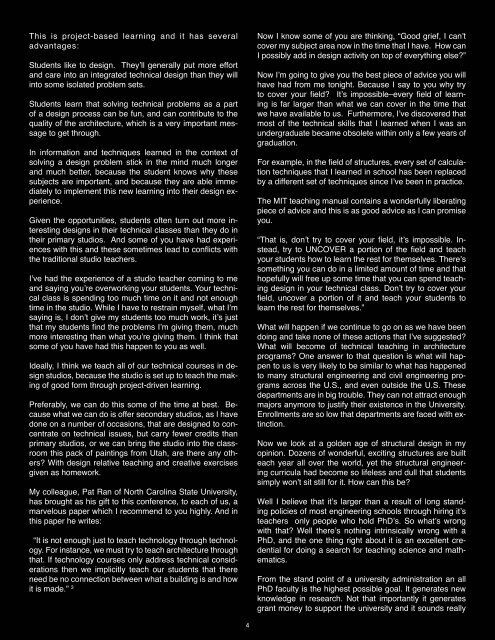Edward Allen BTES 2006 Keynote Speech
Edward Allen BTES 2006 Keynote Speech
Edward Allen BTES 2006 Keynote Speech
- No tags were found...
You also want an ePaper? Increase the reach of your titles
YUMPU automatically turns print PDFs into web optimized ePapers that Google loves.
This is project-based learning and it has severaladvantages:Students like to design. They’ll generally put more effortand care into an integrated technical design than they willinto some isolated problem sets.Students learn that solving technical problems as a partof a design process can be fun, and can contribute to thequality of the architecture, which is a very important messageto get through.In information and techniques learned in the context ofsolving a design problem stick in the mind much longerand much better, because the student knows why thesesubjects are important, and because they are able immediatelyto implement this new learning into their design experience.Given the opportunities, students often turn out more interestingdesigns in their technical classes than they do intheir primary studios. And some of you have had experienceswith this and these sometimes lead to con icts withthe traditional studio teachers.I’ve had the experience of a studio teacher coming to meand saying you’re overworking your students. Your technicalclass is spending too much time on it and not enoughtime in the studio. While I have to restrain myself, what I’msaying is, I don’t give my students too much work, it’s justthat my students nd the problems I’m giving them, muchmore interesting than what you’re giving them. I think thatsome of you have had this happen to you as well.Ideally, I think we teach all of our technical courses in designstudios, because the studio is set up to teach the makingof good form through project-driven learning.Preferably, we can do this some of the time at best. Becausewhat we can do is offer secondary studios, as I havedone on a number of occasions, that are designed to concentrateon technical issues, but carry fewer credits thanprimary studios, or we can bring the studio into the classroomthis pack of paintings from Utah, are there any others?With design relative teaching and creative exercisesgiven as homework.My colleague, Pat Ran of North Carolina State University,has brought as his gift to this conference, to each of us, amarvelous paper which I recommend to you highly. And inthis paper he writes:“It is not enough just to teach technology through technology.For instance, we must try to teach architecture throughthat. If technology courses only address technical considerationsthen we implicitly teach our students that thereneed be no connection between what a building is and howit is made.” 3Now I know some of you are thinking, “Good grief, I can’tcover my subject area now in the time that I have. How canI possibly add in design activity on top of everything else?”Now I’m going to give you the best piece of advice you willhave had from me tonight. Because I say to you why tryto cover your eld? It’s impossible–every eld of learningis far larger than what we can cover in the time thatwe have available to us. Furthermore, I’ve discovered thatmost of the technical skills that I learned when I was anundergraduate became obsolete within only a few years ofgraduation.For example, in the eld of structures, every set of calculationtechniques that I learned in school has been replacedby a different set of techniques since I’ve been in practice.The MIT teaching manual contains a wonderfully liberatingpiece of advice and this is as good advice as I can promiseyou.“That is, don’t try to cover your eld, it’s impossible. Instead,try to UNCOVER a portion of the eld and teachyour students how to learn the rest for themselves. There’ssomething you can do in a limited amount of time and thathopefully will free up some time that you can spend teachingdesign in your technical class. Don’t try to cover your eld, uncover a portion of it and teach your students tolearn the rest for themselves.”What will happen if we continue to go on as we have beendoing and take none of these actions that I’ve suggested?What will become of technical teaching in architectureprograms? One answer to that question is what will happento us is very likely to be similar to what has happenedto many structural engineering and civil engineering programsacross the U.S., and even outside the U.S. Thesedepartments are in big trouble. They can not attract enoughmajors anymore to justify their existence in the University.Enrollments are so low that departments are faced with extinction.Now we look at a golden age of structural design in myopinion. Dozens of wonderful, exciting structures are builteach year all over the world, yet the structural engineeringcurricula had become so lifeless and dull that studentssimply won’t sit still for it. How can this be?Well I believe that it’s larger than a result of long standingpolicies of most engineering schools through hiring it’steachers only people who hold PhD’s. So what’s wrongwith that? Well there’s nothing intrinsically wrong with aPhD, and the one thing right about it is an excellent credentialfor doing a search for teaching science and mathematics.From the stand point of a university administration an allPhD faculty is the highest possible goal. It generates newknowledge in research. Not that importantly it generatesgrant money to support the university and it sounds really4









